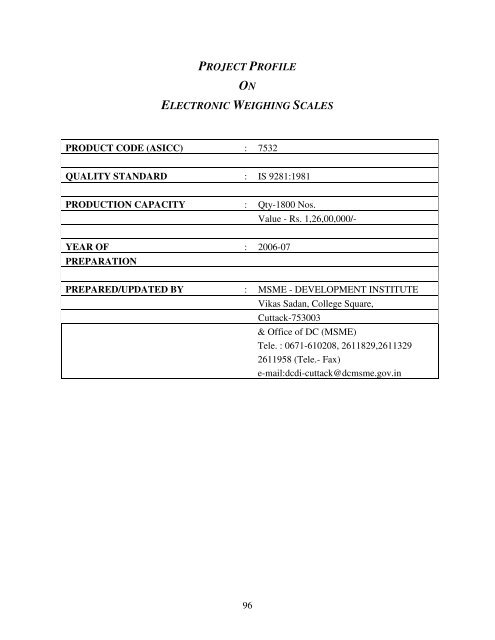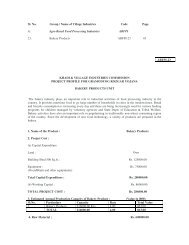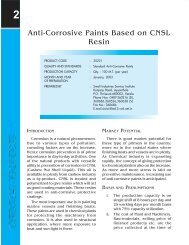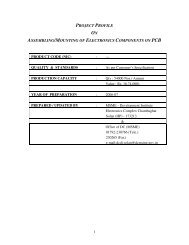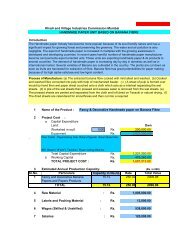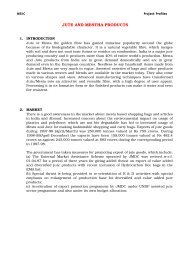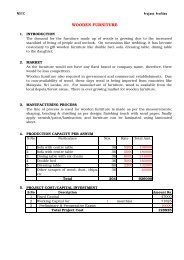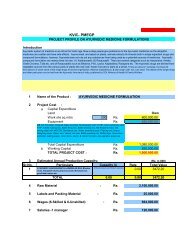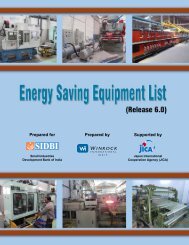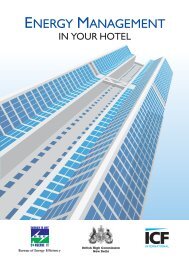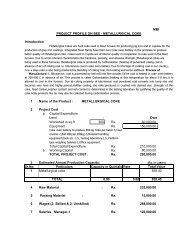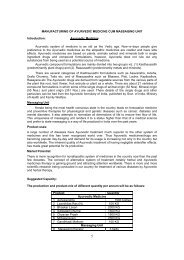PROJECT PROFILE ELECTRONIC WEIGHING SCALES - Dc Msme
PROJECT PROFILE ELECTRONIC WEIGHING SCALES - Dc Msme
PROJECT PROFILE ELECTRONIC WEIGHING SCALES - Dc Msme
You also want an ePaper? Increase the reach of your titles
YUMPU automatically turns print PDFs into web optimized ePapers that Google loves.
<strong>PROJECT</strong> <strong>PROFILE</strong><br />
ON<br />
<strong>ELECTRONIC</strong> <strong>WEIGHING</strong> <strong>SCALES</strong><br />
PRODUCT CODE (ASICC) : 7532<br />
QUALITY STANDARD : IS 9281:1981<br />
PRODUCTION CAPACITY : Qty-1800 Nos.<br />
Value - Rs. 1,26,00,000/-<br />
YEAR OF : 2006-07<br />
PREPARATION<br />
PREPARED/UPDATED BY : MSME - DEVELOPMENT INSTITUTE<br />
Vikas Sadan, College Square,<br />
Cuttack-753003<br />
& Office of DC (MSME)<br />
Tele. : 0671-610208, 2611829,2611329<br />
2611958 (Tele.- Fax)<br />
e-mail:dcdi-cuttack@dcmsme.gov.in<br />
96
1. INTRODUCTION<br />
Electronic weighing systems are used in industries and business establishments for<br />
weighing and segregating materials accurately for process sales. The main advantages of an<br />
electronic weighing system when compared with mechanical weighing systems are:<br />
(a) Compactness and small size independent of capacity.<br />
(b) Ruggedness and high dependability.<br />
(c) High speed of response and rapid weighing.<br />
(d) Good accuracy.<br />
(e) Excellent flexibility to monitor multiple loads.<br />
(f) Analog and digital with printout facility remote indication and parallel display.<br />
(g) Online processing through computer.<br />
The electronic weighing system comprises the basic load cell, suitable signal<br />
conditioners and output recorders/ indicators giving both the analog and digital output for<br />
further processing. The signals from the load cell are amplified and fed to analog/digital<br />
converter, which provide an output in the digital format for display/ printing/processing etc.<br />
The strain gauge based load cell is the most popular weight transducer used in the electronic<br />
weighing system.<br />
2. MARKET POTENTIAL<br />
The total production in industrial electronic and control instrumentation is showing<br />
growth rate every year. This product requires a good marketing set up duly backed by after<br />
sales service facilities. In the state like Orissa, this product has hues demand as because<br />
suppliers are procuring various types of digital weighing scales from Delhi, Kolkata and<br />
Hariyana which are insufficient to meet the local market demand hence, manufacturing of<br />
electronic weighing scales in the home state, positively will bring down it’s price and also it<br />
will be possible to facilitate the consumers after sales service which may in turn create<br />
sufficient demand. In this concept, it is preferred to manufacture, electronic weighing scales<br />
which does have better market potential now and even in future<br />
3. BASIS AND PRESUMPTIONS<br />
(i)<br />
The basis for calculation of production capacity has been taken on single shift of 8 hrs. per<br />
day basis on 75% efficiency.<br />
97
(ii) The maximum capacity utilization on single shift basis for 300 days a year. During first<br />
year and second year of operations, the capacity utilization is 60% and 80% respectively.<br />
The unit is expected to achieve full capacity utilization from “the third year onwards.<br />
(iii) The salaries and wages, cost of raw materials, utilities, civil construction etc. are based on<br />
the prevailing rates in and around north India. These cost factors are likely to vary with<br />
time and location.<br />
(iv) Interest on term loan and working capital loan has been taken at the rate of 16% on an<br />
average. This rate may vary depending upon the policy of the financial<br />
institutions/agencies from time to time.<br />
(v) The cost of machinery and equipments refer to a particular make/model and prices are<br />
approximate.<br />
(vi) The break-even point percentage indicated is of full capacity utilization.<br />
(vii) The project preparation cost etc. whenever required could be considered under preoperative<br />
expenses.<br />
(viii) The essential production machinery and test equipment required for the project have been<br />
indicated. The unit may also utilize common test facilities available at Electronics Test<br />
and Development Centres (ETDCs) and Electronic Regional Test Laboratories (ERTLs)<br />
set up by the State Governments and STQC, Directorate of the Department of Information<br />
Technology, Ministry of Communication and Information Technology, to manufacture<br />
products conforming to Bureau of Indian Standards.<br />
Implementation Schedule<br />
The major activities in the implementation of the project has been listed and the average time<br />
for implementation of the project is estimated at 12 months:<br />
Period in<br />
Sl.No. Name of Activity Months<br />
(Estimated)<br />
1. Preparation of project report 1<br />
2. Registration and other formalities 1<br />
3. Sanction of loan by financial institutions 3<br />
4. Plant and Machinery:<br />
(a) Placement of orders 1<br />
98
(b) Procurement 2<br />
(c) Power connection/ Electrification 2<br />
(d) Installation/Erection of machinery/Test Equipment 2<br />
5. Procurement of raw materials 2<br />
6. Recruitment of Technical Personnel etc. 2<br />
7. Trial production 11<br />
8. Commercial production 12<br />
Notes<br />
1. Many of the above activities shall be initiated concurrently.<br />
2. Procurement of raw materials commences from the 8th month onwards.<br />
3. When imported plant and machinery are required, the implementation period of project may<br />
vary from 12 months to 15 months.<br />
TECHNICAL ASPECTS<br />
1. PROCESS OF MANUFACTURE<br />
The manufacturing process involves the assembly of load cell, electronic circuits and<br />
electro mechanical hardware. Subsequently, the electronics assembly the ICs, transistor, diodes,<br />
resistors, capacitors transformer, coils, relays, potentiometers are assembled on PCBs as per<br />
design.<br />
The assembled PCBs are tested for performance. Subsequently the electronics assembly<br />
along with electromechanical assembly, hardware such as connectors/switches, terminals<br />
display, meters are assembled and housed in a metallic / fibre / plastic case with an appealing<br />
front panel. Finally the assembled unit is calibrated and tested as per the design specification.<br />
2. QUALITY :<br />
IS : 2281/1981<br />
3. PRODUCTION CAPACITY :<br />
Qty : 1800 Nos per annum<br />
Value : Rs. 1,26,00,000<br />
4. MOTIVE POWER : 5 KVA<br />
99
5. Pollution Control<br />
The Govt. accords utmost importance to control environmental pollution. The smallscale<br />
entrepreneurs should have an environmental friendly attitude and adopt pollution control<br />
measures by process modification and technology substitution.<br />
India having acceded to the Montreal Protocol in Sept. 1992, the production and use of<br />
Ozone Depleting Substances (ODS) like Chlorofluoro Carbon (CFC), Carbon Tetrachloride,<br />
Halons and Methyl Chloroform etc. need to be phased out Immediately with alternative<br />
chemicals/solvents. A notification for detailed Rules to regulate ODS phase out under the<br />
Environment Protection Act, 1986 have been put in place with effect from 19th July, 2000.<br />
The following steps are suggested which may help to control pollution in electronics<br />
industry wherever applicable:<br />
(i) In electronic industry fumes and gases are released during hand soldering / wave<br />
soldering/Dip soldering, which are harmful to people as well as environment and<br />
the end products. Alternate technologies may be used to phase out the existing<br />
polluting technologies. Numerous new fluxes have been developed containing 2-<br />
10% solids, as opposed to the traditional 15-35% solids.<br />
(ii) Electronic industry uses ‘CFC, Carbon Tetrachloride and Methyl Chloroform for<br />
cleaning of printed circuit boards after assembly to remove flux residues left after<br />
soldering, and various kinds of foams for packaging.<br />
Many alternative solvents could replace CFC-113 and Methyl Chloroform in electronics<br />
cleaning. Other Chlorinated solvents such as Trichloroethylene, Perchloroethylene and<br />
Methylene Chloride have been used as effective cleaners in electronics industry for many years.<br />
Other organic solvents such as Ketones and Alcohols are effective in removing both solder<br />
fluxes and many polar contaminants.<br />
6. Energy Conservation<br />
With the growing energy needs and shortage coupled with rising energy cost, a greater<br />
thrust in energy efficiency in industrial sector has been given by the Govt. of India since 1980s.<br />
The Energy Conservation Act, 2001 has been enacted on 18th August, 2001, which provides<br />
for efficient, use of energy, its conservation and capacity building of Bureau of Energy<br />
Efficiency oreated under the Act.<br />
The following steps may help for conservation of electrical energy:<br />
i) Adoption of energy conserving technologies, production aids and testing facilities.<br />
100
ii)<br />
Efficient management of process/manufacturing machineries and systems, QC and<br />
testing equipments for yielding maximum Energy Conservation.<br />
iii) Optimum use of electrical energy for heating during soldering process can be<br />
obtained by using efficient temperature controlled soldering and de-soldering<br />
stations.<br />
iv) Periodical maintenance of motors, compressors etc.<br />
v) Use of power factor correction capacitors. Proper selection and layout of lighting<br />
system; timely switching on /off of the lights; use of compact fluorescent lamps<br />
wherever possible etc.<br />
Financial Aspects<br />
(i) Land and Building<br />
Built up area<br />
Office & Stores<br />
Factory Shed<br />
Assembling & Testing<br />
500 Sqr. meters<br />
150 sqr. meter<br />
200 sqr. meter<br />
1500 sqr. meter<br />
Payable / annum Rs. 1,08,000/-<br />
(II) Machinery and Equipments.<br />
Sl. No. Description Ind./ Imp. Qty. Rate (Rs.) Value (Rs.)<br />
1. Bench Drilling machine ½ Ind. 1 @15000 15,000<br />
2. Digital Multi Meter (3½ digits) Ind. 3 @9000 27,000<br />
3. Oscilloscope (0-20 MHz) Ind. 1 @50,000 50,000<br />
4. IC Tester/EPROM Programmer Ind. 1 @50,000 50,000<br />
5. Digital LCR Meter Ind. 1 @45,000 45,000<br />
6. Load Cell Simulator (Imported) Ind. 1 @90,000 90,000<br />
7. Portable Grinder Ind. 1 @20,000 20,000<br />
8. Power Supply (0-30V, 2A) Ind. 2 @10,000 20,000<br />
9. Standard Weights Brass Ind. LS LS 30,000<br />
10. Multi-meter (Analog) Ind. 1 @4,500 4,500<br />
11. UV Eraser, Ind. 1 @6,000 6,000<br />
12. Variac (4A) Ind. 2 @10,000 20,000<br />
Total cost 3,77,500<br />
101
Other fixed Assets<br />
13. Electrification charge @ 10% on<br />
machinery and equipments<br />
37,750<br />
14. Office Furniture and Equipments 1,00,000<br />
15. Tools, Dies, Jigs & Fixtures 60,000<br />
16. Pre-operative expenses 30,000<br />
Total fixed capital 6,05,250<br />
Working Capital (per month)<br />
(i) Staff & Labour<br />
Sl. Designation No. of Salary/ Total Salary<br />
No. Persons month (Rs.)<br />
1. Manager 1 10,000 10,000<br />
2. Production Engineer 1 8,000 8,000<br />
3. Sales & Marketing peronnel 3 5,000 15,000<br />
4. Accountant 1 5,000 5,000<br />
5. Steno./ typist 1 4,000 4,000<br />
6. Purchase and stores personnel 3 4,000 12,000<br />
7. Skilled workers 8 6000 48,000<br />
8. Semi Skilled workers 4 4000 16,000<br />
9. Watchman and peon 3 3000 9,000<br />
+ Perquisites@ 15% of Salary 19,050<br />
Total 1,46,050<br />
102
(ii) Raw Material (Per month)<br />
Sl. Description Ind./ Qty. Rate/ Vaule (Rs.)<br />
No. Inp. Unit<br />
1. Cabinet/Housing (Metal) Ind. 150 @400 60,000<br />
2. Capacitors Ind. 150 @200 30,000<br />
3. Fluorescent display (Imp) Ind. 150 @12,000 1,80,000<br />
4. Integrated circuits (Imp) Ind. 150 @1,500 2,25,000<br />
5. Load cell (strain gauge) (Imp) Ind. 150 @4,000 6,00,000<br />
6. Mechanical hardware Ind. 150 @500 75,000<br />
7. Noise filter (Imp) Ind. 150 @200 30,000<br />
8. PCB Ind. 150 @400 60,000<br />
9. Rectifier (lmp) Ind. 150 @150 22,500<br />
10. Resistors (Diodes and switches) Ind. 150 @250 37,500<br />
11. Transformer Ind. 150 @150 22,500<br />
12. Transistors Ind. 300 @200 60,000<br />
13. Wires, cable connectors,<br />
consumables and packing material<br />
etc.<br />
Ind. 150 @400 60,000<br />
Total 1,462,500<br />
(iii) Utilities (per month)<br />
Power 8,000<br />
Water 1,000<br />
Total 9,000<br />
103
(iv) Other Contingent Expenses (per month)<br />
1. Advertisement 30,000<br />
2. Conveyance expenses 15,000<br />
3. Transport and packaging 20,000<br />
4. Misc. expenses 15,000<br />
5. Postage and stationery 5,000<br />
6. Traveling expenses 30,000<br />
7. Repair and maintenance 3,000<br />
8. Insurance and taxes 5,000<br />
9. Rent (Per month) 9,000<br />
Total 1,32,000<br />
Total Recurring expenditure per month (i + ii + iii + iv)<br />
= Rs. 1,46,050 + Rs. 1,462,500 + Rs. 9,000 + Rs.1,32,000<br />
= Rs. 1,749,550/-<br />
Total Capital Investment<br />
Fixed capital Rs. 6,05,250<br />
Working capital for 3 months Rs. 5,248,650<br />
Total Rs. 5,853,900<br />
104
Financial Analysis<br />
Cost of Production (per annum)<br />
Depreciation on pl. & m/c @ 10% 37,750<br />
Depreciation on office equipement & furniture @ 20% 20,000<br />
Depreciation on Tools, Dies, Jigs & Fixtures@ 25% 15,000<br />
Recurring expenditure per annum 2,09,94,600<br />
Interest on capital investment @ 16% 9,36,624<br />
Turnover (per annum)<br />
Total 2,20,03,974<br />
Item Qty. Rate/Unit (Rs.) Total sales (Rs.)<br />
Electronic weighing 1800 Nos. 13,500/- 2,43,00,000<br />
scales upto 10 Kg<br />
Profit Before Taxes<br />
= Turnover per annum - Cost of production per annum<br />
= Rs. 22,96,026/-<br />
Profit Ratio = Profit / annum x 100 = 22,96,026 x 100 = 9.4%<br />
Sales/ annum 2,43,00,000<br />
Rate of Return = Profit / annum x 100 = 22,96,026 = 39.2%<br />
Total capital Investment 58,53,900<br />
Break-even Point<br />
Rent per Annum 1,08,000<br />
Total Depreciation on Tools, Dies, Jigs & Furniture @ 25 % 15,000<br />
Depreciation on pl. & m/c @ 10% 37,750<br />
Depreciation on office equipement & furniture @ 20% 20,000<br />
Interest on total capital investment @ 16 % 9,36,624<br />
105
Insurance per Annum 60,000<br />
40% Salaries and wages 6,09,600<br />
40% other contingent expenses(excluding 1nsurance, tax 5,66,400<br />
and rent)<br />
Total Fixed Cost 23,53,374<br />
Break-even Point = Fixed cost x 100 = 50.6%<br />
Fixed cost + Profit<br />
Additional Information<br />
(a) The Project Profile may be modified/tailored to suit the individual entrepreneurship<br />
qualities/capacity, production programme and also to suit the locational characteristics,<br />
wherever applicable.<br />
(b) The Electronics Technology is undergoing rapid strides of change and there is need for<br />
regular monitoring of the national and international technology scenario. The unit may,<br />
therefore, keep abreast with the new technologies in order to keep them in pace with<br />
the developments for global competition.<br />
(c)<br />
Quality today is not only confined to the product or service alone. It also extends to the<br />
process and environment in which they are generated. The ISO 9000 defines standards<br />
for Quality Management Systems and ISO 14001 defines standards for Environmental<br />
Management System for acceptability at international level. The unit may therefore<br />
adopt these standards for global competition.<br />
(d) The margin money recommended IS 25% of the working capital requirement at an<br />
average. However, the percentage of margin money may vary as per bank’s discretion.<br />
Name and Addresses of Machinery and Equipment Suppliers<br />
1. M/s. Agronic Instrument (P) Ltd. 201,Shiva-Shakti Industrial state,Mumbai-86.<br />
2. M/s. Bergen Associates Pvt. Ltd. 1082, Sector 27-B, Chandigarh-19.<br />
3. M/s. BPL (India) Ltd. 84, M. G. Road, Bangalore-560001.<br />
4. M/s. Circuit Aids Inc. No. 5, Ranganathapura Magadi Road, Bangalore-79.<br />
5. M/s. Navanidhi Electronics (P)Ltd. 1-60/1 Snehapuri, Nacharaam, Hyderabad-7<br />
6. M/s. Noble Electronics 354,Lajpat Rai Market, Delhi-6.<br />
106
7. M/s. Peico Electronics and Electrical Ltd. Shivasagar, Estate, Block-A,<br />
Dr. Annie Besant Road, Mumbai-12.<br />
8. M/s. Quality Machine Tools 34, J.C. Road, VISL Building, Bangalore-2.<br />
9. M/s. Swastic Machine Tools 4, Lata Chambers, Nashik-422 002.<br />
10. M/s.Sysco Associates 30/106 (New No.234) 11th Main, Malleswaram, Bangalore-3<br />
Name and Addresses of Raw Material Suppliers<br />
1. M/s. Amar Radio Corpn. 11/1,Thiglar Periyanna Lane, SJP Road, Bangalore-2.<br />
2. M/s. Applied Electronics Ltd. A-5,Wagle Industrial Estate, Thane-4, (Mumbai)<br />
3. M/s. Bakumbhai Ambalal Electronics Dept. Kaiser-T-Hind Building, Ballard Estate,<br />
Mumbai-38.<br />
4. M/s. Bangalore Electronics No.124, Sadarpatrappa Road, Bangalore-2.<br />
5. M/s. Electronics Trade and Technology Dev. 15/48, Malcha Marg, New Delhi-2l.<br />
6. M/s. General Electronics 19,5th Floor, Tardeo Air Conditioned Market, Mumbai-34.<br />
7. M/s. Inde Associates 16, Rest House Crescent, Off Church Street, Bangalore-l.<br />
8. M/s. Interco Ltd. 456, Alexandra Road, 14.00 NOL Bldg. Singapore-0511.<br />
9. M/s. Jairamadas and Sons (P.) Ltd. Mittal Towers, M.G. Road, Bangalore.<br />
10. M/s. Micropack Ltd. Plot 16, Jigami Indl. Area, Anekal Taluk, Bangalore District- 560<br />
002.<br />
11. M/s. Namtech Systems(P) Ltd. 35, Dacosta Square, St. Thamas Town, Bangalore-84,<br />
12. M/s. OEN Connectors Ltd. Vyattila, PB No.2, Cochin-19.<br />
13. M/s. Rosemound Ine P.O. Box 35129, Minneapolis, MN 56435 (612) 941-5560, USA (For<br />
scissors)<br />
14. M/s. Saini Electronics Pushapadant Nivas, 3, Chuman Lane, Dr. D. Bhadkamkar Marg.<br />
Mumbai-7.<br />
15. M/s. Southern Electronics No.113, Sadarpatrappa Road, Bangalore-2.<br />
16. M/s. Systronics 202-1206, Harsha House, Near Milan Cinema, arampura Road, New Delhi-<br />
110015.<br />
17. M/s. Tomson Electronics Pulickkal Buildings, Pallimukku, MG Road, Cochin<br />
18. M/s. Shilpa International 107, Parklane, Secunderabad-3<br />
107


